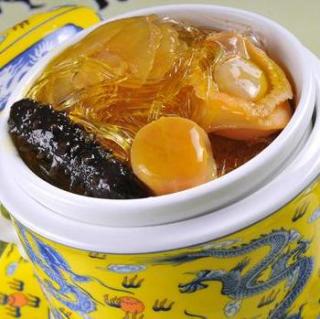
介绍:
更多内容和完整文稿请关注我们10.5日的微信:英语环球 NEWSPlus
The foods of southeast China are exceptionally diverse. Fujian, moist and both semitropical and tropical, is in that region. For those who divide Chinese food by compass points, Fujian, is distinctly eastern and has culinary similarities with nearby regions. Its foods are influenced by rivers, a long coastline, and its inland rugged mountains, some reaching to the sea. One of the eight Chinese culinary traditions, Fujian cuisine is known for the heaps of fresh seafood, a plethora of thin and thick soups and a masterful use of seasoning. Fujian dishes are loved so much by its fans that they say they are the tastiest of all Chinese food. We now follow our reporter Wang Ling to Fujian to try some of those dishes.
As 'Min' is the abbreviation of Fujian, the local cuisine is more commonly called Min Cai in Chinese. Like other eastern cuisines, the flavor of Fujian cuisine is relatively light. Particularly, this unique light flavor is integrated with some special content, which is a soft, tender and umami taste. Instead of deep processing on the ingredients taste, Fujian cuisine places strong emphasis on retaining the original flavor.
With the enormous advantages of its geographic location, seafood and woodland products are both abundant in Fujian to supply varied and fresh ingredients for cooking.
Fang Bing-gui is a Fujian native and food expert.
"Fujian has lots of coastline on the eastern side and many interior mountains that reach the sea. With access to salt water and large rivers such as the Min, there is a plethora of foods available from both fresh and salt water, foods grown on the mountain slopes, and on other available land. The coastal area produces nearly 200 varieties of fish and 90 kinds of shellfish. All of these products are used in Fujian cuisine. "
The signature Fujian dish "Buddha Jumps Over the Wall" is the best example of local chefs�� creativity in extracting the best flavors from ingredients available.
The curious name comes from the story of a monk who walks by a home where someone is cooking a fragrant soup. It smells so good that the monk who, according to the dictates of his faith, should have a vegetarian diet, jumps over the wall and drinks some of the soup. When he is caught sampling a dish with meat in it, he replies it is so good that even Buddha would jump over the wall to eat it.
Chef Yang Wei-hua specializes in cooking "Buddha Jumps Over the Wall"; and explains why this soup is so irresistible.
"Dozens of ingredients are used to cook the soup, including fish maw, abalone, sea cucumber, dried scallops, ginseng, deer tendon, mushrooms and pigeon eggs. We make the soup base first using chicken, lean pork and Chinese ham, and let it simmer for hours. We add the rest of the ingredients and simmer it some more before serving. Premium Shaoxing rice wine is also added to bring out the flavors."
Yang says that the preparation of the ingredients takes even longer than the actual cooking of the dish, as each type of dried seafood has its own specifications in terms of how it needs to be rehydrated. Dried sea cucumber, for example, needs to be soaked for 3 to 4 days beforehand, while dried fish maw should be soaked in hot water.
With so many pricey ingredients used and such careful preparation, it's really no wonder that it diverted Buddha from his vegetarian diet.
Another notable aspect of Fujian cuisine is that its dishes are mostly served in soup form. There is a local saying that a meal without soup is unacceptable. Nearly half of the local dishes are served in soup form. But why do Fujian people especially love soup dishes? Fang Bing-gui explains.
"The regional climate, which is moist heat, has helped spawn Fujian peoples love for soup. There can be as many as five different soups in one main meal. It wouldn't be appropriate for northerners to prepare so many soupy dishes in one meal; the soup would get cold quickly in chilly weather, and the dishes flavors would be lost. "
Inevitable, that the Fujian people are soup connoisseurs; and that the local chefs go to great lengths to prepare the base stock for a good soup. It can take several hours, but when the final result is filtered, it yields a very clear broth that is rich in colour, fragrance and flavor, and is well worth the effort.
After that, Fujian chefs transform the base stock into varieties of soups, soupy dishes and stews by adding different ingredients and sauces; and simmering again to let time do the magic. Yang Wei-hua again.
"Soup is the soul of Min dishes. We have clear cooked with meat, chicken, and spare ribs. We also have richer, thicker varieties made with seafood and meat. These soup bases will then be used to cook more soupy dishes."
One special soup variety is laced with local red wine paste or lees, a left-over sediment from making rice wine, which is another invention by the local chefs.
Known as Hong Zao locally, the red wine paste coats the ingredients to be preserved, usually chicken or meat, to give both texture and color. The various Hong Zao recipes include Drunken Spare Ribs, Braised Meat in Red Wine Sauce, and Pork Pickled in Wine.
Fujian chefs are experts in using various kinds of sauces and seasonings to create salty, sweet, sour and spicy tastes. Though the soy sauce made in this region is famous, only a little is used in dishes, and more is incorporated into dipping sauces. The local chefs prefer using fish sauce, shrimp sauce, and shrimp oil as substitute of soy sauce. But in general, Fujian dishes tend to have a slightly sweet and sour side to them. Fang Bing-gui tells us more.
大家还在听

